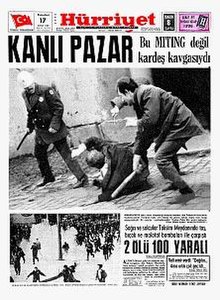
Bloody Sunday (Turkish: Kanlı Pazar) is the name given to a counter-revolutionary response to a leftist protest that occurred on February 16, 1969, in Istanbul's Beyazıt Square, Turkey.
At eleven o'clock ten thousands of left-wing students supported by labor unions and the labor party started gathering in Beyazıt in order to protest against the dropping anchor of the United States Sixth Fleet at the Bosporus. The route of demonstration began at the Beyazıt Square, went over Karaköy, Tophane and Gümüşsuyu where they paid tribute to death of the student Vedat Demircioğlu at the Istanbul Technical University. Meanwhile, right-wing students met at the Dolmabahçe Mosque for the suppression of the leftist protest and prayed before they moved on. The police, the official representative of the state, was already waiting at Taksim to both wings. Around four pm, finally, the clash occurred at the Taksim Square and turned the streets into a battlefield. Batons and knives were pulled, Molotov cocktails were hurled. The day resulted in the death of two leftist people and numerous injured.
Background
A coup d'état in 1960 had allowed a group of Turkish military officers to take control of the country. Under this established government, labor tensions grew and anti-American sentiment rose. Elements of the Turkish left and labour movement were protesting against what they regarded as American imperialism.
Protests increased after the United States Sixth Fleet arrived in Turkey. Unrest peaked on February 16, 1969, when 30,000 people marched on Taksim Square. The demonstration was broken up by the police, but several thousand continued the march towards Taksim. It was at this point that a counter-revolutionary force attacked a large group of these protesters with knives and sticks. During this confrontation, two protesters, Ali Turgut and Duran Erdoğan, were killed. Feroz Ahmad, a prominent Indian Turkey expert, refers to Bloody Sunday as "an example of organized, fascist violence", alluding to right-wing elements responsible for most of the violence.
Political tensions between the right-wing and the left-wing ran high for most of the 1960s and 1970s. Similar attacks on labor groups by right-wing elements in the government and Turkish politics occurred in 1971 and 1977. The 1977 massacre is referred to as Turkey's "second Bloody Sunday".
See also
References
- Serap, Gungor (12 January 2016). "The Bloody Sunday of Istanbul". We Love Istanbul.
- Karasapan, Omer. Turkey and US Strategy in the Age of Glasnost. Middle East Report, No. 160, Turkey in the Age of Glasnost (Sep. - Oct., 1989), p. 6
- Amineh, Mehdi Parvizi; Houweling, Henk (June 2007). "Global Energy Security and Its Geopolitical Impediments: The Case of the Caspian Region". Perspectives on Global Development and Technology. 6 (1–3): 365–388. doi:10.1163/156914907X207793.
- Kasaba, Resat Ed. (2008). Turkey in the Modern World. The Cambridge History of Turkey. Vol. 4. Cambridge University Press. pp. xvii, 226–266.
- Karasapan, Omer. Turkey and US Strategy in the Age of Glasnost. Middle East Report, No. 160, Turkey in the Age of Glasnost (Sep. - Oct., 1989), p. 8
- "Istanbul Protests". Turkish Daily News. February 17, 2001. Archived from the original on January 9, 2007. Retrieved 2008-04-25.
- Ahmad, Feroz (1977). The Turkish Experiment in Democracy: 1940-1975. Boulder, CO, USA: Westview Press. p. 381.
- Başkan, Filiz (January 2006). "Globalization and Nationalism: The Nationalist Action Party of Turkey". Nationalism and Ethnic Politics 12 (1): 83-105.
- Ahmad, Feroz. Military Intervention and the Crisis in Turkey. MERIP Reports, No. 93, Turkey: The Generals Take Over (Jan., 1981), p. 10,22
- 1969 murders in Turkey
- 1969 riots
- 1960s in Istanbul
- February 1969 events in Asia
- February 1969 events in Europe
- Violence against protesters
- Protest-related deaths
- 20th-century political riots
- Riots and civil disorder in Turkey
- Political repression in Turkey
- Neo-fascism in Turkey
- Political violence in Turkey
- Anti-American sentiment in Turkey
- Murder in Istanbul
- Arson in Turkey
- Arson in the 1960s
- 1969 fires
- 1960s fires in Europe
- Counter-revolution
- Knife attacks in Europe
- Mass stabbings in Europe
- Student protests in Europe